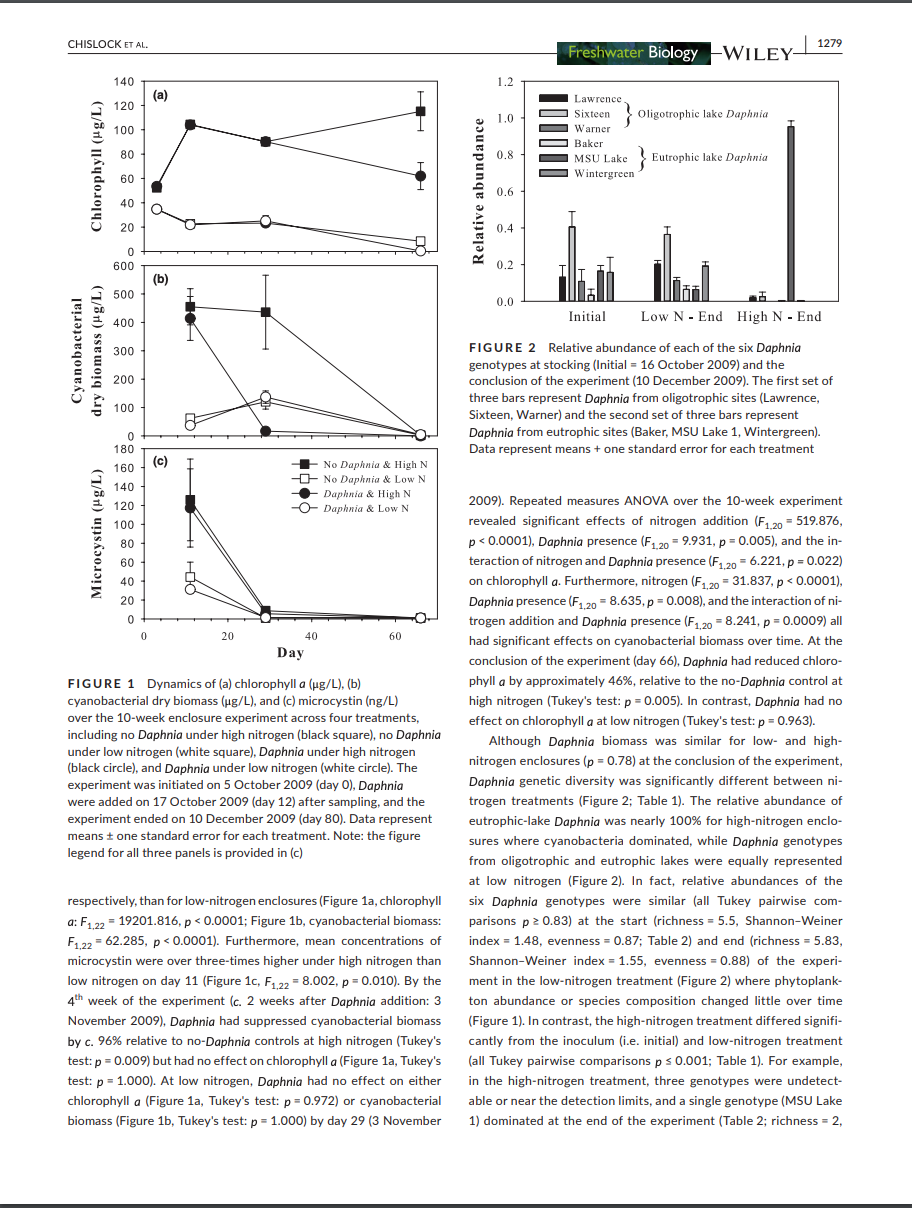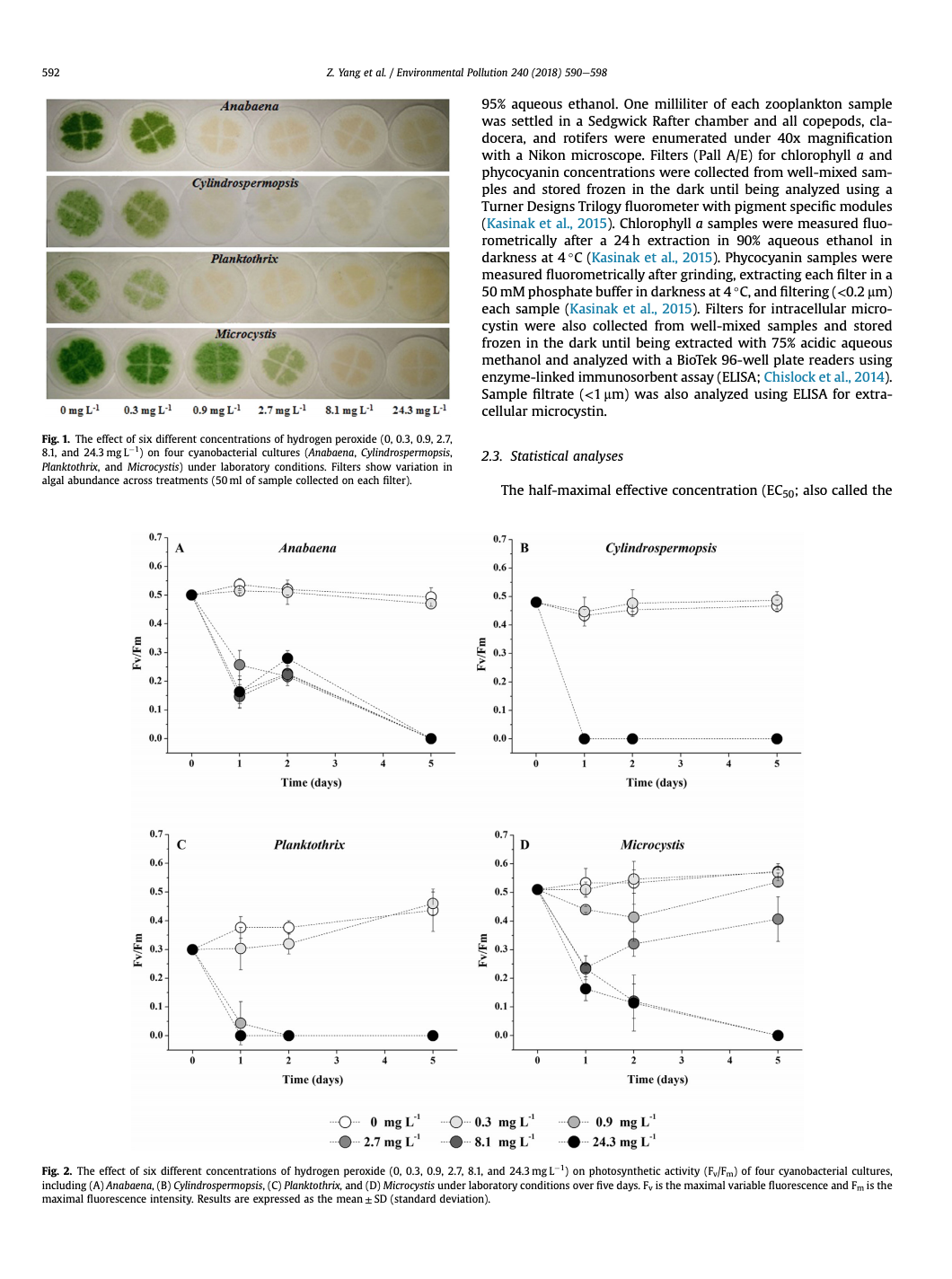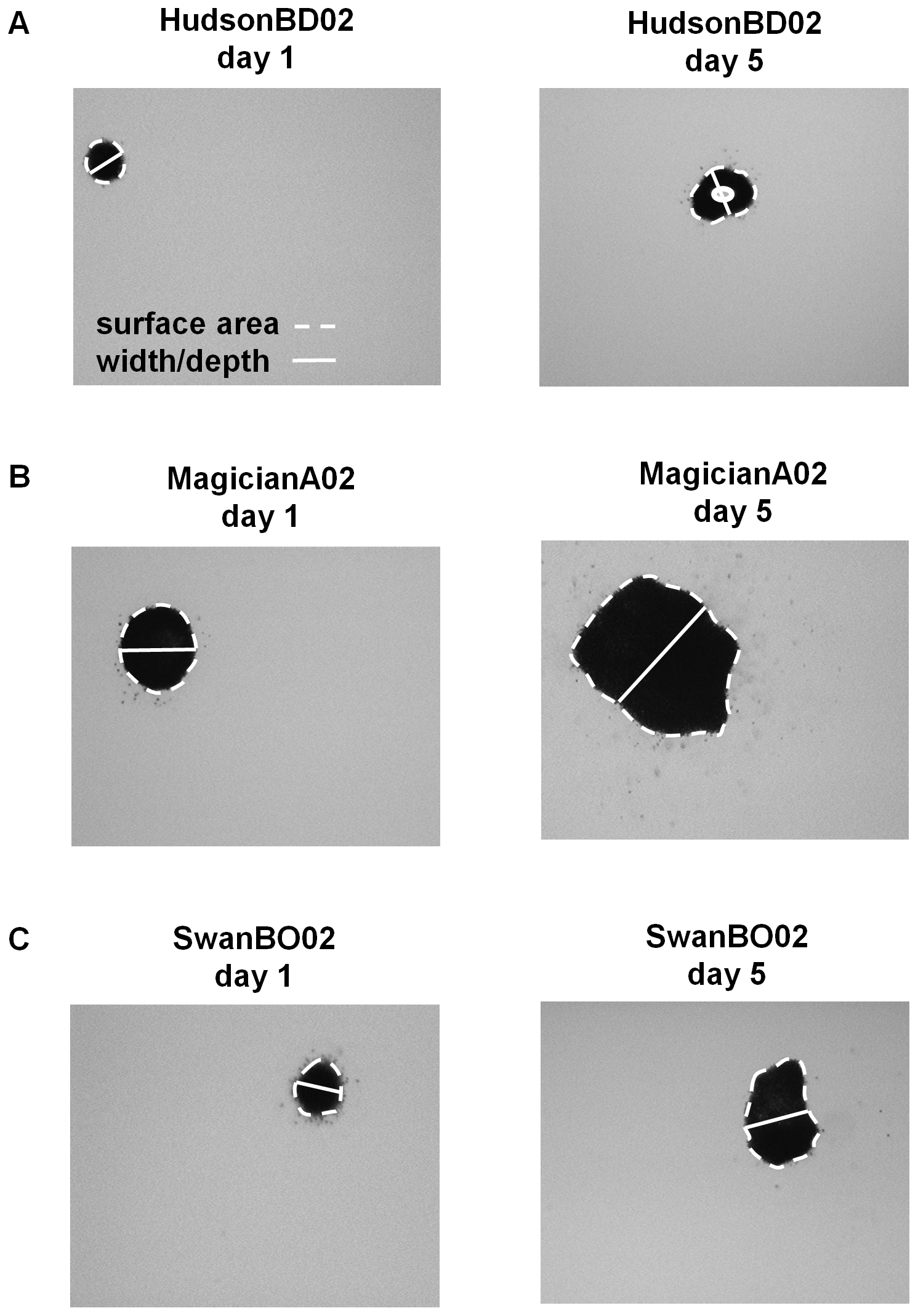Keyword: Phytoplankton

Hyman, M., Q. Wang, A. E. Wilson, S. Adhikari, and B. T. Higgins. 2021. Production of Daphnia zooplankton on wastewater-grown algae for sustainable conversion of waste nutrients to fish feed. Journal of Cleaner Production 310:127501.
Abstract
This study investigates the upcycling of nutrients in anaerobic digestate via algal biomass to zooplankton which is a natural fish feed. There are no published studies, to the authors’ knowledge, on the viability of growing zooplankton on digestate-grown algae. Here, the viability of digestate-grown Chlorella sorokiniana as a feed for the large-bodied generalist zooplankter, Daphnia, was tested. It was found that Daphnia fed with digestate-grown C. sorokiniana led to 1.5- to 14-fold greater Daphnia population growth than Daphnia fed with Ankistrodesmus sp., an established feed. A sterol analysis of C. sorokiniana found 4–6 mg/g of the sterol, ergosterol, and nearly double the α-linolenic acid content of Ankistrodesmus. Sterols and α-linolenic acid are often-limiting nutrients in Daphnia diets. Other factors hypothesized to influence nutrient transfer from algae to Daphnia were also tested, including algal feed concentration, sterol supplementation, and the presence of digestate bacteria in the algal feed. The presence of bacteria and exogenous cholesterol had no significant impacts on Daphnia growth. The higher feed concentration (5 mg C/L) led to 3 times higher Daphnia growth than the low feed concentration (1.5 mg C/L) even though the latter concentration has frequently been used by other researchers. Finally, it was determined that the feed conversion ratio of algae to Daphnia fell in the range of 0.19–0.31 and that trophic transfer of carbon was 25–28% while that of nitrogen was 29–34% in this un-optimized system. These values compare favorably to livestock feed conversion efficiency but additional losses will occur when Daphnia are fed to fish. These results show that cultivation of Daphnia on digestate-grown algae is technically feasible.

Chislock, M. F., R. B. Kaul, K. A. Durham, O. Sarnelle, and A. E. Wilson. 2019. Eutrophication mediates rapid clonal evolution in Daphnia pulicaria. Freshwater Biology 64:1275-1283.
Abstract
- Laboratory studies have revealed that Daphnia species can evolve to tolerate toxic cyanobacteria in the diet. Specifically, Daphnia from eutrophic lakes where cyanobacteria are common tend to have higher growth rates and survival when fed toxic cyanobacteria than populations from oligotrophic environments with low abundance of cyanobacteria.
- We conducted an in‐lake mesocosm (i.e. limnocorral) experiment during the autumn of 2009 to assess the effects of nutrient enrichment on clonal evolution in Daphnia pulicaria. As nutrient enrichment often favours grazing‐resistant cyanobacteria, we hypothesised that fertilisation would influence the genotypic composition of D. pulicaria that vary in tolerance to cyanobacteria. Mesocosms were fertilised to manipulate phytoplankton and cyanobacterial abundance and concentrations of a cyanobacterial toxin (microcystin). Thus, half of the mesocosms were high‐nutrient and half were low‐nutrient. We then stocked half of the mesocosms with a mixture of six genetically‐distinct D. pulicaria genotypes (three genotypes from oligotrophic lakes and three from eutrophic lakes) leaving half of the mesocosms Daphnia‐free to assess grazing effects, using a fully factorial design.
- When compared to the low nutrient treatment, high nutrient mesocosms had nearly five‐fold higher chlorophyll a concentrations, eight‐fold higher cyanobacterial dry biomass, and three‐fold higher microcystin levels at the start of the experiment. In contrast, low nutrient mesocosms had phytoplankton concentrations typical of mesotrophic lakes.
- Fertilisation strongly affected Daphnia genetic diversity in the mesocosms. Final Daphnia genotype diversity in the mesocosms with low‐cyanobacteria (richness = 5.83, Shannon–Weiner index = 1.55, evenness = 0.88) was similar to the initial stocked diversity (richness = 5.50, Shannon–Weiner index = 1.48, evenness = 0.87). In contrast, final diversity in fertilised mesocosms with high cyanobacteria was greatly reduced (richness = 2, Shannon–Weiner index = 0.17), with one Daphnia genotype that originated from the most‐eutrophic lake being highly dominant (evenness = 0.25). Thus, eutrophication mediated strong clonal selection of a cyanobacteria‐tolerant Daphnia genotype over just 10 weeks.
- By the end of the experiment, Daphnia significantly reduced phytoplankton biomass in the high‐nutrient, but not in the low‐nutrient treatment. This difference in effect size was largely driven by the five‐fold higher initial phytoplankton biomass in the high‐nutrient treatment. Thus, the ability of Daphnia to reduce phytoplankton biomass in eutrophic lakes may be driven more so by the abundance of planktivorous fishes, as opposed to the prevalence of cyanobacteria and their associated toxins.

Yang, Z., R. P. Buley, E. G. Fernandez-Figueroa, M. U.G. Barros, S. Rajendran, and A. E. Wilson. 2018. Hydrogen peroxide treatment promotes chlorophytes over toxic cyanobacteria in a hyper-eutrophic aquaculture pond. Environmental Pollution 240:590-598.
Abstract
Controlling blooms of toxigenic phytoplankton, including cyanobacteria, is a high priority for managers of aquatic systems that are used for drinking water, recreation, and aquaculture production. Although a variety of treatment approaches exist, hydrogen peroxide (H2O2) has the potential to be an effective and ecofriendly algaecide given that this compound may select against cyanobacteria while not producing harmful residues. To broadly evaluate the effectiveness of H2O2 on toxigenic phytoplankton, we tested multiple concentrations of H2O2 on (1) four cyanobacterial cultures, including filamentous Anabaena, Cylindrospermopsis, and Planktothrix, and unicellular Microcystis, in a 5-day laboratory experiment and (2) a dense cyanobacterial bloom in a 7-day field experiment conducted in a nutrient-rich aquaculture pond. In the laboratory experiment, half-maximal effective concentrations (EC50) were similar for Anabaena, Cylindrospermopsis, and Planktothrix (average EC50 = 0.41 mg L-1) but were ∼10x lower than observed for Microcystis (EC50 = 5.06 mg L-1). Results from a field experiment in an aquaculture pond showed that ≥1.3 and ≥ 6.7 mg L-1 of H2O2 effectively eliminated Planktothrix and Microcystis, respectively. Moreover, 6.7 mg L-1 of H2O2 reduced microcystin and enhanced phytoplankton diversity, while causing relatively small negative effects on zooplankton abundance. In contrast, 20 mg L-1 of H2O2 showed the greatest negative effect on zooplankton. Our results demonstrate that H2O2 can be an effective, rapid algaecide for controlling toxigenic cyanobacteria when properly dosed.

Wilson, A. E., R. B. Kaul, and O. Sarnelle. 2010. Growth rate consequences of coloniality in a harmful phytoplankter. PLoS ONE 5(1):e8679.
Abstract
Background
Allometric studies have shown that individual growth rate is inversely related to body size across a broad spectrum of organisms that vary greatly in size. Fewer studies have documented such patterns within species. No data exist directly documenting the influence of colony size on growth rate for microscopic, colonial organisms.
Methodology/Principal Findings
To determine if similar negative relationships between growth rate and size hold for colonial organisms, we developed a technique for measuring the growth of individual colonies of a bloom-forming, toxic cyanobacterium, Microcystis aeruginosa using microscopy and digital image analysis. For five out of six genotypes of M. aeruginosa isolated from lakes in Michigan and Alabama, we found significant negative relationships between colony size and growth rate. We found large intraspecific variation in both the slope of these relationships and in the growth rate of colonies at a standard size. In addition, growth rate estimates for individual colonies were generally consistent with population growth rates measured using standard batch culture.
Conclusions/Significance
Given that colony size varies widely within populations, our results imply that natural populations of colonial phytoplankton exist as a mosaic of individuals with widely varying ecological attributes (since size strongly affects growth rate, grazing mortality, and migration speed). Quantifying the influence of colony size on growth rate will permit development of more accurate, predictive models of ecological interactions (e.g., competition, herbivory) and their role in the proliferation of harmful algal blooms, in addition to increasing our understanding about why these interactions vary in strength within and across environments.